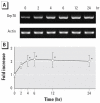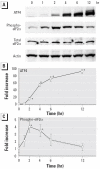Cadmium induces the expression of Grp78, an endoplasmic reticulum molecular chaperone, in LLC-PK1 renal epithelial cells
- PMID: 16759985
- PMCID: PMC1480533
- DOI: 10.1289/ehp.8920
Cadmium induces the expression of Grp78, an endoplasmic reticulum molecular chaperone, in LLC-PK1 renal epithelial cells
Abstract
To reveal the effects of cadmium exposure on the endoplasmic reticulum (ER) stress response, we examined the expression and function of 78-kDa glucose-regulated protein (Grp78) , an ER-resident molecular chaperone, in LLC-PK1 cells. In cells treated with 10 microM cadmium chloride, Grp78 protein levels increased after 6 hr and remained elevated at 24 hr. When cells were incubated with 1-20 microM CdCl2 for 6 hr, Grp78 increased in a dose-dependent manner. In addition, Grp78 mRNA levels were elevated in response to CdCl2 exposure. After exposure to 10 microM CdCl2, the levels of activating transcription factor 4 (ATF4) were increased at 2 hr, with a further enhancement after that ; this accumulation followed the transient but marked phosphorylation of the alpha subunit of eukaryotic translation initiation factor 2 (eIF2(alpha)) on serine 51. Although ATF4 mRNA levels increased mildly by CdCl2 exposure, treatment with actinomycin D did not suppress CdCl2-induced accumulation of ATF4 protein, suggesting the involvement of posttranscriptional and, in part, transcriptional mechanisms. Compared with other heavy-metal compounds such as manganese chloride, zinc chloride, mercuric chloride, and lead chloride, CdCl2 could increase the levels of Grp78, ATF4, and the phosphorylated form of eIF2(alpha) more markedly without definite cellular damage. The silencing of Grp78 expression using short-interference RNA enhanced CdCl2-induced cellular damage. These results show that cadmium induces the expression of Grp78 probably via phosphorylation of eIF2(alpha) and resultant translation of ATF4, and this ER stress response plays a role in protection against cadmium cytotoxicity in this renal epithelial cell.
Figures







Similar articles
-
PI3K signaling mediates diverse regulation of ATF4 expression for the survival of HK-2 cells exposed to cadmium.Arch Toxicol. 2014 Feb;88(2):403-14. doi: 10.1007/s00204-013-1129-y. Epub 2013 Sep 22. Arch Toxicol. 2014. PMID: 24057571
-
Atypical, bidirectional regulation of cadmium-induced apoptosis via distinct signaling of unfolded protein response.Cell Death Differ. 2007 Aug;14(8):1467-74. doi: 10.1038/sj.cdd.4402154. Epub 2007 Apr 27. Cell Death Differ. 2007. PMID: 17464326
-
Celecoxib upregulates endoplasmic reticulum chaperones that inhibit celecoxib-induced apoptosis in human gastric cells.Oncogene. 2006 Feb 16;25(7):1018-29. doi: 10.1038/sj.onc.1209139. Oncogene. 2006. PMID: 16205636
-
Coping with stress: eIF2 kinases and translational control.Biochem Soc Trans. 2006 Feb;34(Pt 1):7-11. doi: 10.1042/BST20060007. Biochem Soc Trans. 2006. PMID: 16246168 Review.
-
Regulation of translational initiation during cellular responses to stress.Prog Nucleic Acid Res Mol Biol. 1998;58:79-125. doi: 10.1016/s0079-6603(08)60034-3. Prog Nucleic Acid Res Mol Biol. 1998. PMID: 9308364 Review.
Cited by
-
Cell organelles as targets of mammalian cadmium toxicity.Arch Toxicol. 2020 Apr;94(4):1017-1049. doi: 10.1007/s00204-020-02692-8. Epub 2020 Mar 23. Arch Toxicol. 2020. PMID: 32206829 Review.
-
Cadmium Protection Strategies--A Hidden Trade-Off?Int J Mol Sci. 2016 Jan 21;17(1):139. doi: 10.3390/ijms17010139. Int J Mol Sci. 2016. PMID: 26805823 Free PMC article. Review.
-
Single-prolonged stress induces endoplasmic reticulum-dependent apoptosis in the hippocampus in a rat model of post-traumatic stress disorder.PLoS One. 2013 Jul 19;8(7):e69340. doi: 10.1371/journal.pone.0069340. Print 2013. PLoS One. 2013. PMID: 23894451 Free PMC article.
-
Fibroblasts from naked mole-rats are resistant to multiple forms of cell injury, but sensitive to peroxide, ultraviolet light, and endoplasmic reticulum stress.J Gerontol A Biol Sci Med Sci. 2008 Mar;63(3):232-41. doi: 10.1093/gerona/63.3.232. J Gerontol A Biol Sci Med Sci. 2008. PMID: 18375872 Free PMC article.
-
Cadmium induces transcription independently of intracellular calcium mobilization.PLoS One. 2011;6(6):e20542. doi: 10.1371/journal.pone.0020542. Epub 2011 Jun 9. PLoS One. 2011. PMID: 21694771 Free PMC article.
References
-
- Brostrom MA, Brostrom CO. Calcium dynamics and endoplasmic reticular function in the regulation of protein synthesis: implications for cell growth and adaptability. Cell Calcium. 2003;34:345–363. - PubMed
-
- Cigliano S, Remondelli P, Minichiello L, Mellone MC, Martire G, Bonatti S, et al. Analysis of metal-regulated metallo-thionein and heat shock gene expression in HeLa-derived cadmium-resistant cells. Exp Cell Res. 1996;228:173–180. - PubMed
-
- Croute F, Beau B, Murat J-C, Vincent C, Komatsu H, Obata F, et al. Expression of stress-related genes in a cadmium-resistant A549 human cell line. J Toxicol Environ Health A. 2005;68:703–718. - PubMed
-
- Elia G, De Marco A, Rossi A, Santoro MG. Inhibition of HSP70 expression by calcium ionophore A23187 in human cells. An effect independent of the acquisition of DNA-binding activity by the heat shock transcription factor. J Biol Chem. 1996;271:16111–16118. - PubMed
Publication types
MeSH terms
Substances
LinkOut - more resources
Full Text Sources
Miscellaneous

